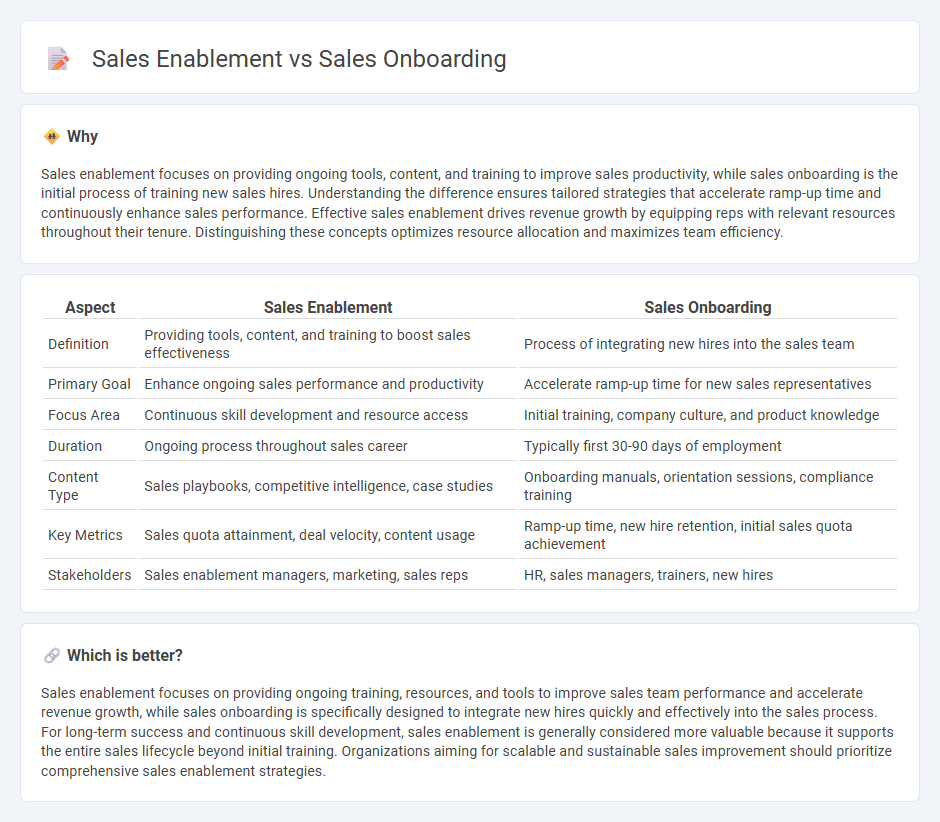
Sales enablement focuses on providing ongoing resources, tools, and training to improve sales teams' performance and close rates, while sales onboarding specifically targets the initial training and integration of new sales hires. Effective sales enablement drives sustained revenue growth by aligning marketing and sales strategies, whereas onboarding establishes a strong foundation for new employees through product knowledge and company culture immersion. Explore how optimizing both can accelerate your sales team's success.
Why it is important
Sales enablement focuses on providing ongoing tools, content, and training to improve sales productivity, while sales onboarding is the initial process of training new sales hires. Understanding the difference ensures tailored strategies that accelerate ramp-up time and continuously enhance sales performance. Effective sales enablement drives revenue growth by equipping reps with relevant resources throughout their tenure. Distinguishing these concepts optimizes resource allocation and maximizes team efficiency.
Comparison Table
| Aspect | Sales Enablement | Sales Onboarding |
|---|---|---|
| Definition | Providing tools, content, and training to boost sales effectiveness | Process of integrating new hires into the sales team |
| Primary Goal | Enhance ongoing sales performance and productivity | Accelerate ramp-up time for new sales representatives |
| Focus Area | Continuous skill development and resource access | Initial training, company culture, and product knowledge |
| Duration | Ongoing process throughout sales career | Typically first 30-90 days of employment |
| Content Type | Sales playbooks, competitive intelligence, case studies | Onboarding manuals, orientation sessions, compliance training |
| Key Metrics | Sales quota attainment, deal velocity, content usage | Ramp-up time, new hire retention, initial sales quota achievement |
| Stakeholders | Sales enablement managers, marketing, sales reps | HR, sales managers, trainers, new hires |
Which is better?
Sales enablement focuses on providing ongoing training, resources, and tools to improve sales team performance and accelerate revenue growth, while sales onboarding is specifically designed to integrate new hires quickly and effectively into the sales process. For long-term success and continuous skill development, sales enablement is generally considered more valuable because it supports the entire sales lifecycle beyond initial training. Organizations aiming for scalable and sustainable sales improvement should prioritize comprehensive sales enablement strategies.
Connection
Sales enablement and sales onboarding are interconnected processes that enhance sales team performance by providing targeted training, resources, and tools. Sales enablement ensures ongoing access to updated content and best practices, while sales onboarding focuses on equipping new hires with the knowledge and skills required to start selling effectively. Together, they create a seamless learning experience that accelerates ramp-up time and drives consistent revenue growth.
Key Terms
**Sales Onboarding:**
Sales onboarding is the structured process of integrating new sales hires into a company by providing essential training, product knowledge, and company culture alignment to accelerate their time-to-productivity. It involves tailored learning paths, consistent mentorship, and performance metrics to ensure sales representatives meet quota expectations efficiently. Explore more to enhance your sales onboarding strategies for improved team performance.
Training Curriculum
Sales onboarding primarily emphasizes developing a structured training curriculum designed to equip new sales hires with foundational product knowledge, company processes, and sales techniques. Sales enablement extends beyond onboarding to provide continuous learning resources, advanced training modules, and performance support tools to enhance sales team effectiveness and adaptability. Discover how implementing a strategic training curriculum transforms both onboarding and enablement processes for sustained sales success.
Ramp-up Time
Sales onboarding focuses on the initial training period designed to equip new sales hires with essential knowledge, tools, and company processes, significantly impacting ramp-up time by accelerating their readiness to engage customers. Sales enablement encompasses ongoing support, content, technology, and resources that continuously enhance sales performance beyond the onboarding phase, reducing ramp-up time for both new and existing sales team members. Discover how optimizing ramp-up time through strategic onboarding and enablement drives faster revenue growth and greater sales productivity.
Source and External Links
How to build an effective sales onboarding program - Sales onboarding is best structured over 60-90 days with clear weekly goals including company values, CRM training, role-playing, live-call shadowing, and ongoing coaching to accelerate ramp-up time by 37% and improve rep productivity more quickly.
How to Build a Sales Onboarding Process for New Hires - An effective sales onboarding process includes crafting a strategy based on business metrics, delivering practical and interactive training with accountability, and enabling sellers to reach full productivity with ongoing measurement and support.
7 Effective Sales Onboarding Steps & Best Practices - Successful sales onboarding involves setting measurable objectives, following a 30-60-90 day plan with clear milestones like call shadowing, lead generation, and closing deals, and providing ready resources to minimize ramp-up time effectively.
 dowidth.com
dowidth.com